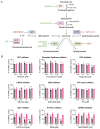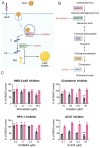Chikungunya Replication and Infection Is Dependent upon and Alters Cellular Hexosylceramide Levels in Vero Cells
- PMID: 40284952
- PMCID: PMC12031450
- DOI: 10.3390/v17040509
Chikungunya Replication and Infection Is Dependent upon and Alters Cellular Hexosylceramide Levels in Vero Cells
Abstract
Chikungunya virus (CHIKV), a mosquito-borne alphavirus, causes significant global morbidity, including fever, rash, and persistent arthralgia. Utilizing untargeted lipidomics, we investigated how CHIKV infection alters host cell lipid metabolism in Vero cells. CHIKV infection induced marked catabolism of hexosylceramides, reducing their levels while increasing ceramide byproducts. Functional studies revealed a reliance on fatty acid synthesis, β-oxidation, and glycosphingolipid biosynthesis. Notably, inhibition of uridine diphosphate glycosyltransferase 8 (UGT8), essential for galactosylceramide production, significantly impaired CHIKV replication and entry in Vero cells. Sensitivity of CHIKV to UGT8 inhibition was reproduced in a disease-relevant cell line, mouse hepatocytes (Hepa1-6). CHIKV was also sensitive to evacetrapib, a cholesterol ester transfer protein (CETP) inhibitor, though the mechanism of inhibition appeared independent of CETP itself, suggesting an off-target effect. These findings highlight specific lipid pathways, particularly glycosphingolipid metabolism, as critical for CHIKV replication and further refine our understanding of how CHIKV exploits host lipid networks. This study provides new insights into CHIKV biology and suggests that targeted investigation of host lipid pathways may inform future therapeutic strategies.
Keywords: alphavirus; chikungunya virus; fatty acid synthesis; hexosylceramide; lipidomics.
Conflict of interest statement
The authors declare no conflicts of interest. The funders had no role in the design of the study; in the collection, analyses, or interpretation of data; in the writing of the manuscript; or in the decision to publish the results.
Figures











Similar articles
-
Generation and characterization of infectious clones of chikungunya virus from an Indian strain as a resource towards chikungunya vaccine research.Virus Res. 2025 Jun;356:199571. doi: 10.1016/j.virusres.2025.199571. Epub 2025 Apr 9. Virus Res. 2025. PMID: 40216162 Free PMC article.
-
Chlorinated biscoumarins inhibit chikungunya virus replication in cell-based and animal models.Emerg Microbes Infect. 2025 Dec;14(1):2529889. doi: 10.1080/22221751.2025.2529889. Epub 2025 Jul 28. Emerg Microbes Infect. 2025. PMID: 40608982 Free PMC article.
-
Establishment of a Chikungunya virus pseudotype system strictly dependent on viral protein expression.J Gen Virol. 2025 Aug;106(8). doi: 10.1099/jgv.0.002138. J Gen Virol. 2025. PMID: 40788659
-
Evidence of previous but not current transmission of chikungunya virus in southern and central Vietnam: Results from a systematic review and a seroprevalence study in four locations.PLoS Negl Trop Dis. 2018 Feb 9;12(2):e0006246. doi: 10.1371/journal.pntd.0006246. eCollection 2018 Feb. PLoS Negl Trop Dis. 2018. PMID: 29425199 Free PMC article.
-
Prevalence of chronic comorbidities in chikungunya: A systematic review and meta-analysis.Int J Infect Dis. 2018 Feb;67:107-113. doi: 10.1016/j.ijid.2017.12.018. Epub 2017 Dec 20. Int J Infect Dis. 2018. PMID: 29277382 Free PMC article.
References
-
- Weaver S.C., Lecuit M. Chikungunya virus and the global spread of a mosquito-borne disease. N. Engl. J. Med. 2015;372:1231–1239. - PubMed
-
- Rodriguez-Morales A.J., Cardona-Ospina J.A., Fernanda Urbano-Garzon S., Sebastian Hurtado-Zapata J. Prevalence of Post-Chikungunya Infection Chronic Inflammatory Arthritis: A Systematic Review and Meta-Analysis. Arthritis Care Res. 2016;68:1849–1858. - PubMed
-
- Gogia A., B S., Kakar A. CHIKUNGUNYA: A Mortality Report. Open Forum Infect. Dis. 2017;4:S518.
Publication types
MeSH terms
Substances
Grants and funding
LinkOut - more resources
Full Text Sources
Medical

